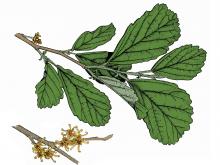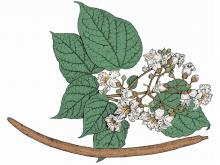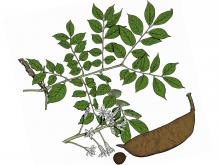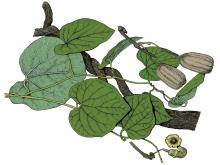Trees, Shrubs and Woody Vines
Media

Species Types
Scientific Name
Gleditsia triacanthos
Description
Though it doesn’t reach a stately size, honey locust commands respect for its many large, strong, usually branched thorns, which can puncture tractor tires as easily as they can poke through tennis shoes! The long, leathery, twisting pods are relished by cattle and by wildlife.
Media

Species Types
Scientific Name
Salix spp. (about 12 species in Missouri)
Description
Exotic willows are available at lawn and garden centers, but there are several willow species that are native to Missouri. Most are rather humble colonizers of gravel bars, riverbanks, and lakesides. Many are important for human economic interests. All have a place in our wild ecosystems.
Media

Species Types
Scientific Name
Campsis radicans
Description
Each summer, the bright orange and red “trumpets” of this woody vine decorate Missouri’s cliff faces, telephone poles, and anything else strong enough to support it. Hummingbirds zoom to trumpet creeper’s flowers for their nectar.
Media

Species Types
Scientific Name
Hamamelis vernalis
Description
Ozark witch-hazel is a large native shrub that grows along dry, rocky streambeds in southern and east-central Missouri. The yellow, ribbonlike flowers bloom as early as January. In the fall, the seeds are ejected forcefully, to a distance of up to 30 feet!
Media

Species Types
Scientific Name
Catalpa speciosa
Description
Of the three species of catalpas in our state, northern catalpa is the only one native to Missouri (specifically, the Bootheel region). It has been planted widely, though, and has naturalized in many places. A popular ornamental and shade tree with pretty, orchidlike flowers and long, beanlike fruit.
Media

Species Types
Scientific Name
Cephalanthus occidentalis
Description
White flowers clustered in round balls give buttonbush its name. It's always found near water, and thickets of buttonbush help protect lakeshores from wave action. This shrub is also planted as an ornamental.
Media

Species Types
Scientific Name
Staphylea trifolia
Description
American bladdernut is a thicket-forming shrub or small tree that grows in moist soils. It produces clusters of bell-shaped white flowers in spring and unusual 3-parted air-filled capsules in late summer that turn papery and persist into winter.
Media

Species Types
Scientific Name
Gymnocladus dioicus
Description
There’s no mistaking Kentucky coffee tree when its large, tough seedpods are hanging from its limbs or dropping to the ground below. Unpopular as food with today’s wildlife, these seedpods might have fed mastodons and other large, extinct North American mammals.
Media

Species Types
Scientific Name
Hypericum hypericoides (formerly Ascyrum hypericoides)
Description
St. Andrew’s cross is a small, sprawling shrub up to 3 feet tall, with smooth, opposite leaves, reddish flaky bark, and distinctive yellow flowers with 4 petals. It grows in the southern half of Missouri.
Media

Species Types
Scientific Name
Aristolochia tomentosa
Description
Woolly pipe-vine is a high-climbing woody vine common along streams in the Ozarks. Hikers and canoeists often don’t notice it because the leaves and unusual flowers are usually high overhead in the trees.
See Also
About Trees, Shrubs and Woody Vines in Missouri
There are no sharp dividing lines between trees, shrubs, and woody vines, or even between woody and nonwoody plants. “Wood” is a type of tissue made of cellulose and lignin that many plants develop as they mature — whether they are “woody” or not. Trees are woody plants over 13 feet tall with a single trunk. Shrubs are less than 13 feet tall, with multiple stems. Vines require support or else sprawl over the ground.





















